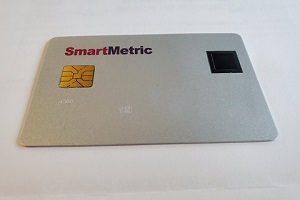SmartMetric develops biometric card that works across card readers

New York, United States – SmartMetric, Inc., has created a biometric card that works with all credit card readers, including restaurants, store checkouts and ATM’s.
Other companies who have attempted to copy the SmartMetric biometric credit card have failed to have a card that works across all card readers. These imitators have not spent the years of R&D that SmartMetric has in developing an internal power system, nor do they have a rechargeable internal battery to enable the card to work without being held in the card reader. The other card companies, because they do not have an internal power source, use the power of the card reader to power the fingerprint reading processor. This requires their card to be held in the card reader while a fingerprint scan of the card holder is done on their card.
This failed system design by other biometric card companies means that the card will not work at ATM’s and most EMV gas pumps that of course “swallow” the card, not permitting the user to hold the card’s fingerprint sensor on the card for a fingerprint scan. Restaurants that take the card from the table and process the payment at their card reading station also will not be able to process these non-powered biometric cards, since such cards need to be held by the card holder when the card is inserted into the card reader. Of course, restaurants that have a portable card reader that is brought to the table will work, but in markets such as the United States, it is a minority of restaurants that have portable to the table card readers.
The imitators of the SmartMetric biometric credit card are based in Europe. An un-powered biometric card may work in more restaurants than in the USA because of the use of portable card readers used at the table. But these cards will not work, even at ATM’s.
The other big issue for non-powered biometric credit cards is that they require that the card holder go into a bank branch to receive their card and use a special fingerprint reading machine to have their fingerprint stored inside the card. The SmartMetric biometric card, because it has its own internal power source and because it uses a separate processor for the biometric scan and match function to the payments chip, is able to enroll a user’s fingerprint at home. As simply as one would enroll a fingerprint on a mobile phone.
The largest card issuing banks in the USA send out their new credit cards via the mail to the card holder’s home. In fact, one the largest card issuers only has a handful of bank branches and is in no position to mass roll out to its customers a card that requires customers to come into a branch for fingerprint enrollment on the card.
“Simply poor thinking and design that has created far too many friction points in the use of biometric cards by imitators leaves the SmartMetric biometric credit card solution without question as the most superior solution for credit card issuers and consumers alike,” says SmartMetric’s president & CEO, Chaya Hendrick.
Trials of the European designed non-powered biometric cards have run into adoption and usage problems for the very reasons that make their biometric cards unfriendly to card issuing banks and their customers.
The SmartMetric biometric credit card solution is without a doubt without peers in the world of biometric cards. Years of research and development with a clear objective of creating a biometric card solution with a user centric focus has given SmartMetric an unbelievable new credit card category product.
SmartMetric believes it has created the most advanced biometric credit card solution in the world. “While others may try to imitate, none have come even close to achieving the advances we have that allow our card to be used in all types of credit card readers in all card usage situations,” says Chaya Hendrick.
As guidance, SmartMetric is now in active manufacture of its latest and most advanced version of its biometric credit and debit card.
“After suffering a great deal of supply chain issues, we are please to say that we are now able to move forward with full card manufacturing with a current capacity of 1 million cards a month,” says Chaya Hendrick.
Comment on this article below or via Twitter @IoTGN
